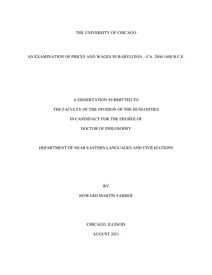This dissertation identifies long term fluctuations in prices and wages
in northern and southern Babylonia during the Isin-Larsa/Old Babylonian
period (ca. 2000-1600 B.C.E.). The introduction orients the reader to
the study of prices and wages. It reviews previous studies, defines
objectives, scope, and methodology, presents an overview of the sources
for prices and wages, and outlines limitations.
The scope of this study includes the following categories:
1) prices paid for real estate (houses, fields, orchards), slaves, and
livestock
2) prices for house rentals
3) prices paid for commodities (barley, oil, wool, dates, and sesame)
4) wages paid for hired labor.
Part I presents and analyzes the data for each category, utilizing
charts and graphs to reveal regional price differences and price (or
wage) fluctuation at a category level.
Part II looks at the data holistically, with the goals of identifying
long-term fluctuations of prices and wages for northern and southern
Babylonia and correlating their movements with political history. It
shows that economic prosperity is, to a large degree, conditional on
periods of political stability, which goes hand in hand with powerful
rulers.
Degree Type
Ph.D.
Content Type
Dissertation
Publication Date
2021-08
Language
en
Record Created
2021-09-29

No comments:
Post a Comment